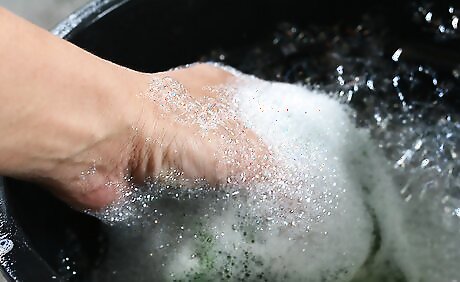
views
Wash the Car Thoroughly

Park the car in a shady spot. Make sure the surface of the car is cool. This will help prevent soap stains from appearing on the car's surface.

Place the soap in a gallon-sized bucket. Add water until the bucket is filled and the water is sudsy. Use only car wash-specific soaps. Read the soap packaging for the amount of soap to dispense.

Take a large sponge and submerge it into the soapy water. Remove the sponge, squeeze out about half of the water, place the sponge on the car and begin washing.

Move the sponge in circular motions across the body of the car, paying special attention to crevices and cracks that may have dirt trapped. Start at the top of the car and work downward. Once the car has been completely cleaned, hose off all of the soap.
Choose a Buffer

Use a high speed buffer to achieve the finest results. High speed buffers will eliminate surface scratches and blemishes completely, leaving behind a brilliant shine. However, training is recommended to master a high speed buffer. Improper use of a high speed buffer can strip the paint and damage the finish permanently by leaving swirls and scratches.

Select a random orbital buffer for great results and a nice sheen with minor effort. No training is required and the random orbital buffer is easy to use. Not all damage will be eliminated but the end result will be a great shine. Random orbital buffers also use significantly less compound than a high speed buffer, therefore a more cost-effective solution. The results will not last as long as with a high speed buffer.

Choose manual buffing if cost is an issue. However, manual buffing is the most labor intensive option that will give the least effective results. Manual buffing takes much longer than high speed and random orbital buffing and the finish will not last as long with manual buffing. Manual buffing requires the least amount of equipment, but requires the most of amount of product and time. The results are usually an uneven finish that will not last as long as alternative buffing means.

Purchase a polishing or compound product that will achieve the desired results with your car. Compound is needed if there are deep scratches in the finish. Polisher is used if the body paint is in great shape already and just needs an increased shine. Product needs will also vary based on the car model, the car year, and the overall condition of the car. Both products can be used with the buffer. Get product recommendations from friends or reputable car aficionados.
Buffing

Dry the car with a chamois or clean, soft towel. Work around the entire car to ensure the car is completely dry.

Apply a generous amount of polisher or compound directly to the body of the car. Begin with the hood to examine results easily.

Place the buffer on the polishing product and move the buffer around to spread the product evenly. Use small, circular motions to effectively buff each portion of the car. If using a powered buffer, turn the buffer on and move the buffer in firm, circular motions to work the entire product into the finish and reveal the shine.Buff a Car Step 11Bullet1.jpg If manual buffing, apply extreme pressure while employing circular motions to work in the product.Buff a Car Step 11Bullet2.jpg

Continue buffing the product into the car's surface until it develops a sheen.

Repeat the process over the entire surface of the car until the desired result is achieved.




















Comments
0 comment